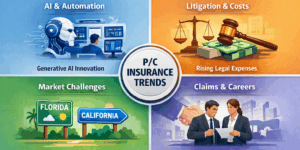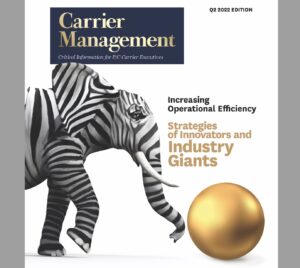

The giant innovator on the cover of this edition teases to the content in these pages, including the accounts of two executives of insurance industry giants, who describe investments in technology to make their operations more efficient.
At a time when inflation worries and investment volatility loom large, carriers like Nationwide and The Hartford are still growing bottom lines. They have spent hundreds of millions of dollars on technology in past years—investments that have ultimately resulted in lower-cost business models for 2022.
Mo Tooker, head of Middle Market and Large Commercial business for The Hartford, describes decade-old IT spends now being leveraged to triage claims and underwriting workflows, innovations in usage-based commercial liability insurance and data firepower to spot emerging risk and claims trends.
Mark Berven, president of Nationwide Property and Casualty, says the future-focused transformations of Nationwide’s personal and commercial lines operations began seven years ago. Since 2015, Nationwide invested about three-quarters of a billion dollars in process and product modernization efforts, and the carrier has taken out over a billion dollars in P/C expenses over the same period.
AM Best provides an overview of what’s happening. “Companies with higher innovation assessments have lower expense ratios,” the rating agency reports. Innovative companies “make a tradeoff between higher expense ratios in the short run and low and more sustainable combined ratios in the long run.”
In Tooker’s view, scale matters. “This is a place where we will feel a bifurcation in the marketplace. There are only a handful of carriers that can make the investments we’re describing.”
Berven points to the ownership structure of his company as a contributor to success. The “flexibility of not having to always be myopically focused on the next earnings call” allows mutuals to take a long-term view of business health and of how they deliver for customers, he says.
Outside of these pages, on the Carrier Management website, another industry giant, Berkshire Hathaway’s Warren Buffett, expressed a similar view about mutuals in our most-read article of the year, “State Farm Still Wins: Buffett Talks Auto Insurance at Annual Event.”
In our second-most popular article of the quarter, “Tesla Insurance Turning ‘Nightmare’ Claims Experience Into ‘Dream’: Musk,” tech innovator Elon Musk talked about aspirations to bring efficiency to the auto claims handling process at Tesla Insurance. Same-day collision repairs will be “a night-and-day difference” to the old-style insurance claims handling “nightmare,” which can involve a month-long wait for claims to be “settled and figured out” by incumbents
Unappreciated by Musk, existing insurance giants also have customer experience in mind. Berven, for example, talked about photo inspections and automated processes, which will ultimately mean lower premium rates.
Also in this edition, Mike Nelson and Stephanie Niehaus of QuantivRisk describe the prospects of using vehicle data to objectively determine liable parties in auto accidents, including the manufacturers of increasingly autonomous vehicle systems. “On The Road Ahead to Level 3 Automation: Paradigm Shift in Crash Fault Assessments“
Musk, meanwhile, has been touting the benefits of real-time insurance pricing from Tesla car data, which generates Safety Scores based on indicators like the number of forward collision warnings a driver receives. He may run into some roadblocks, like a lawsuit filed by a Tesla owner in late April. “Unfortunately, Tesla drivers’ Safety Scores are inflated because of random ‘ghost’ Forward Collision Warnings that Tesla vehicles undergo when there is no actual danger or any car in sight,” the lawsuit seeking class action status alleges. (Shawn Schneider v. State National Insurance Company)
Whether Schneider is right or wrong about the technology behaving badly is still to be decided. But we all know that data collected digitally sometimes gives wrong signals. There is a website of people information that says I am on the board of a D&O broker I once profiled. I am not. And if you Google images of me, you may very well see a photo of my Insurance Journal colleague Chad Hemenway instead.
The carriers we interviewed about their moves to automate are careful.
“Most of what you’re seeing the larger carriers working on is really what I would call augmented intelligence. We’re helping our adjusters or underwriters make decisions in a more informed fashion,” says Tooker.
“Don’t automate everything because there are steps in the process that, from a consumer confidence perspective, that relationship and human voice on the other end of the interaction adds value,” Berven says.






















 California Workers Comp Combined Ratio for 2024 Highest in 20-Plus Years
California Workers Comp Combined Ratio for 2024 Highest in 20-Plus Years  Slideshow: Carrier Management’s 2025 Top Editor’s Picks (Unlocked)
Slideshow: Carrier Management’s 2025 Top Editor’s Picks (Unlocked)  Why ‘Good Enough’ Is Killing Insurance: The Hidden Cost of Satisficing
Why ‘Good Enough’ Is Killing Insurance: The Hidden Cost of Satisficing  What to Expect in 2026: U.S. P/C Results More Like 2024
What to Expect in 2026: U.S. P/C Results More Like 2024 













